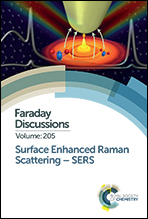Theoretical modeling of voltage effects and the chemical mechanism in surface-enhanced Raman scattering†
Abstract
Theoretical approaches can provide insight into the mechanisms and magnitudes of electromagnetic and chemical effects in surface-enhanced Raman scattering (SERS), properties that are not readily available experimentally. Here, we model the SERS spectra of two geometries of the prototypical Ag20–pyridine cluster using a semiempirical INDO/SCI approach that allows a straightforward decomposition of the enhancement factors at each wavelength into electromagnetic and chemical terms, with proper treatment of resonant charge-transfer contributions to the enhancement. The method also enables us to determine the dependence of the enhancement on the electrochemical potential. We show that the electromagnetic enhancements for the Ag20 cluster are <10 far from resonance but can increase to 102 to 103 on resonance with plasmon excitation in the cluster. The decomposition also shows that for the systems studied here, the chemical enhancements are primarily due to resonance with excited states with significant charge-transfer character. This term is typically <10 but can be >102 at electrochemical potentials where the charge-transfer excited states are resonant with the incoming light, leading to total enhancements of >104.
- This article is part of the themed collection: Surface Enhanced Raman Scattering - SERS


 Please wait while we load your content...
Please wait while we load your content...